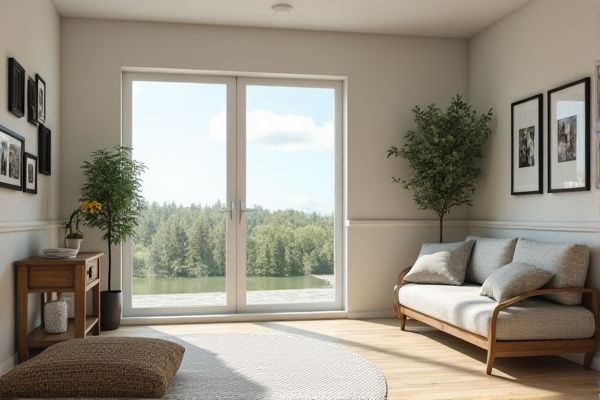
Glass doors offer superior clarity, durability, and resistance to scratching compared to acrylic doors, which are lighter and more impact-resistant but can yellow and scratch over time. Explore the detailed comparison to determine which door type best suits Your needs and environment.
Table of Comparison
| Feature | Glass Doors | Acrylic Doors |
|---|---|---|
| Material | Tempered or laminated glass | Clear or colored acrylic sheets |
| Durability | High resistance to scratches, moderate impact resistance | High impact resistance, prone to scratches |
| Transparency | Crystal clear, no distortion | Clear but can yellow over time |
| Weight | Heavier, requires strong framing | Lighter, easier to install |
| Cost | Generally higher | More affordable |
| Maintenance | Easy to clean, resistant to stains | Susceptible to scratching, requires gentle cleaning |
| Safety | Shatters into small, less harmful pieces (tempered) | Does not shatter, may crack under extreme force |
| Design options | Limited to clear or frosted finishes | Wide range of colors and shapes |
Overview: Glass Doors vs Acrylic Doors
Glass doors offer superior clarity, durability, and scratch resistance, making them ideal for high-traffic areas and elegant designs. Acrylic doors are lightweight, impact-resistant, and more affordable, providing a versatile alternative for budget-conscious projects. Your choice depends on balancing aesthetic appeal with practical functionality and maintenance requirements.
Material Composition and Properties
Glass doors are made from natural silica sand, offering high durability, scratch resistance, and excellent clarity, while acrylic doors consist of lightweight polymethyl methacrylate, known for impact resistance and flexibility. Glass provides superior thermal and acoustic insulation, maintaining transparency over time without yellowing, whereas acrylic can be prone to scratching and discoloration but offers easier customization and lower weight. Your choice depends on the need for strength, clarity, and long-term maintenance in different environments.
Durability and Strength Comparison
Glass doors offer superior scratch resistance and can withstand higher impact without cracking, making them highly durable for long-term use. Acrylic doors provide greater flexibility and are less prone to shattering under force but are more susceptible to scratches and yellowing over time. Choosing between glass and acrylic doors depends on prioritizing either impact resistance or surface durability for specific installation environments.
Aesthetic Appeal and Design Versatility
Glass doors offer a sleek, modern aesthetic with high transparency and reflective qualities that enhance natural light and create a spacious feel. Acrylic doors provide greater design versatility due to their lightweight nature and ability to be molded into various shapes, colors, and textures, allowing for customized and creative interior solutions. Both materials contribute distinct visual appeal, with glass emphasizing elegance and clarity, while acrylic supports vibrant, customizable design options.
Safety Considerations and Impact Resistance
Glass doors offer high impact resistance when made from tempered or laminated glass, providing strong safety features such as shatterproof qualities that minimize injury risks. Acrylic doors, while lighter and less prone to shattering, may scratch easier and have lower impact resistance compared to tempered glass, requiring careful maintenance to preserve safety and clarity. Choosing between glass and acrylic doors depends on balancing impact resistance needs with safety requirements tailored to specific environments.
Maintenance and Cleaning Requirements
Glass doors require regular cleaning with non-abrasive glass cleaners and soft cloths to maintain clarity and prevent streaks, while acrylic doors need gentle cleaning with mild soap and water to avoid scratches and cloudiness. Acrylic surfaces are more prone to scratching and yellowing over time, demanding careful handling and specialized polishes for restoration. Both materials benefit from routine maintenance to preserve appearance, but glass offers higher durability and easier upkeep in high-traffic or outdoor environments.
Cost Analysis: Initial and Long-Term Investment
Glass doors typically have a higher initial cost due to the material and installation but offer superior durability and scratch resistance, making them a better long-term investment in high-traffic areas. Acrylic doors are more budget-friendly upfront, lightweight, and easier to replace, but they may require frequent repairs or replacements due to their susceptibility to scratches and discoloration over time. Evaluating your specific needs and usage environment will help determine which option provides the most cost-effective balance between initial expense and long-term value.
Energy Efficiency and Insulation
Glass doors offer superior energy efficiency due to their excellent thermal insulation properties, especially when double or triple glazed with gas fills and low-emissivity coatings. Acrylic doors, while lighter and less prone to shattering, provide lower insulation performance and can be more susceptible to heat transfer and UV degradation. Choosing glass doors can significantly reduce heating and cooling costs by minimizing thermal exchange compared to acrylic alternatives.
Installation Process and Flexibility
Glass doors require professional installation due to their weight and fragility, ensuring proper sealing and alignment, while acrylic doors offer easier DIY installation thanks to their lightweight and durable nature. Acrylic doors provide greater flexibility in design and customization, allowing for various shapes, colors, and thicknesses, whereas glass doors typically come in standard sizes and styles. Your choice between glass and acrylic should consider the complexity of installation and the desired adaptability for your specific space.
Ideal Applications and Usage Scenarios
Glass doors excel in commercial settings, high-end residential interiors, and areas requiring transparency with durability, such as office partitions and storefronts. Acrylic doors are preferred for lightweight applications, outdoor use, and spaces where impact resistance or shatterproof qualities are crucial, including schools and recreational facilities. Both materials offer versatility, but glass suits elegance and clarity while acrylic caters to safety and cost-effectiveness.
 homyna.com
homyna.com